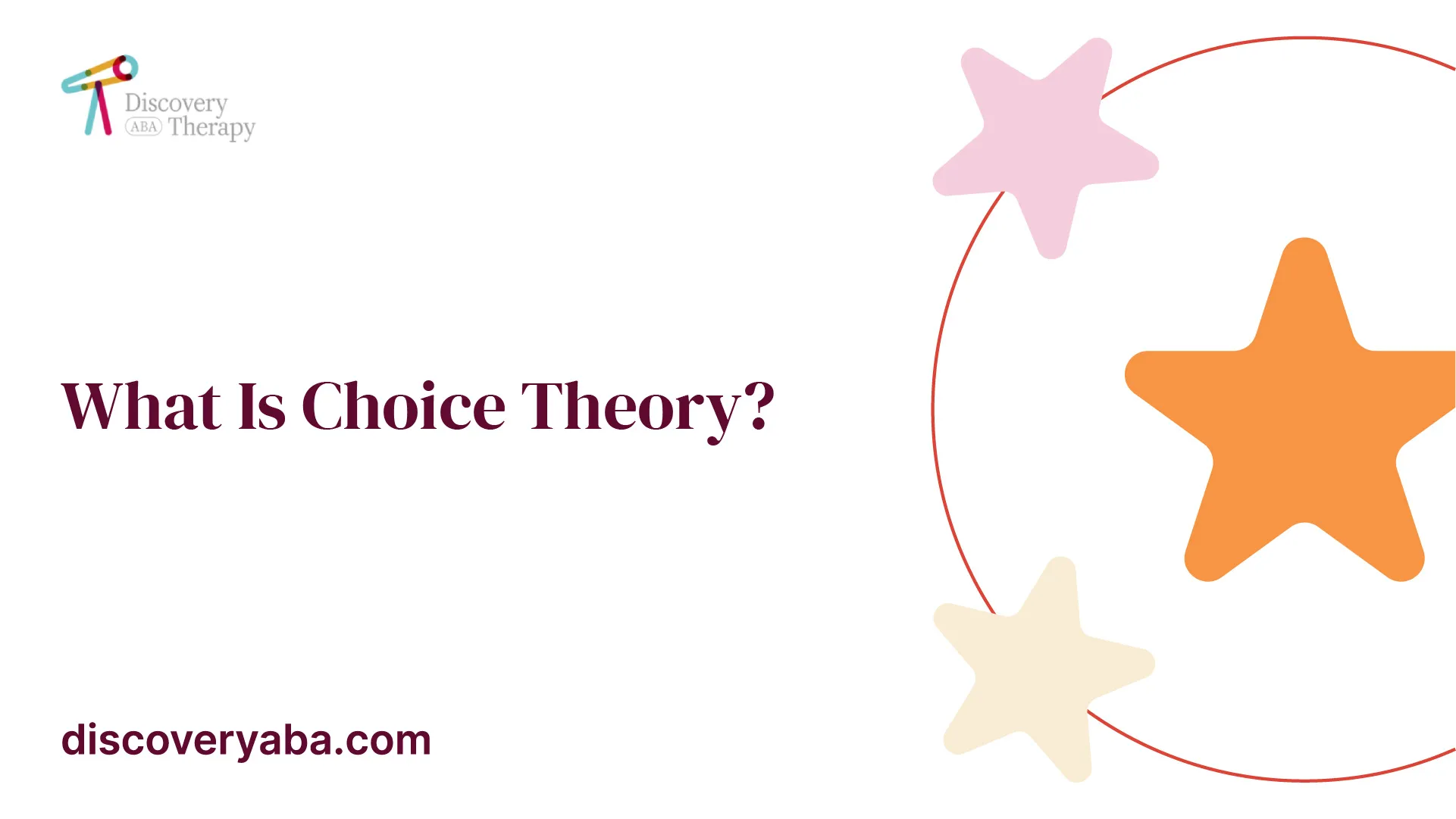What Is Choice Theory?
Embark on a human-centered exploration of Choice Theory. Discover the profound insights into human behavior and decision-making.
.jpeg)
Understanding Choice Theory
Choice Theory, developed by psychiatrist William Glasser, is a psychological approach that explores how individuals make choices and take responsibility for their own actions. By understanding the principles of Choice Theory, individuals can gain insight into their own behavior and make more effective choices in their lives.
What is Choice Theory?
Choice Theory is a concept that emphasizes the idea that every individual has the power to make choices and is responsible for their own behavior. According to this theory, our choices are driven by our internal needs and desires. It suggests that our behavior is an attempt to meet these needs and achieve personal satisfaction.
At its core, Choice Theory asserts that we have the power to control our own actions and make choices that align with our needs and values. It encourages individuals to take ownership of their decisions and understand the consequences that arise from them.

The Key Principles of Choice Theory
Choice Theory is built upon several key principles that shape our understanding of human behavior and decision-making. These principles provide insight into why individuals make certain choices and how these choices impact their overall well-being. Let's explore the core principles of Choice Theory:
- The Basic Needs: Choice Theory posits that all individuals have five basic human needs - survival, love and belonging, power, freedom, and fun. These needs serve as the driving force behind our behavior and choices. By recognizing and understanding these needs, individuals can strive to fulfill them in healthy and productive ways.
- Internal Control: According to Choice Theory, individuals have the power of internal control, meaning they can control their thoughts, feelings, and actions. This principle highlights the importance of taking responsibility for one's choices and understanding that external circumstances do not determine our happiness. By focusing on what we can control internally, we can make choices that align with our needs and values.
- Total Behavior: Choice Theory introduces the concept of total behavior, which asserts that our behavior is comprised of four interconnected components - thinking, feeling, physiology, and actions. These components work together to shape our overall behavior. Understanding this interplay helps individuals gain insight into their choices and identify patterns that may be impacting their well-being.
By understanding Choice Theory and its principles, individuals can gain a deeper awareness of their own decision-making processes and take steps towards making choices that align with their needs and values. This knowledge can be particularly beneficial for individuals with autism and their caregivers in promoting self-understanding and empowerment.
The Basic Needs
In order to understand and apply Choice Theory effectively, it is essential to familiarize ourselves with its foundational principles. The first principle of Choice Theory revolves around recognizing and addressing the basic needs that drive human behavior.
Exploring the Basic Human Needs
According to Choice Theory, every individual has five basic needs that motivate their actions and choices. These needs are:
- Survival: The need for physical well-being, including food, water, shelter, and safety.
- Love and Belonging: The need for connection, affection, and a sense of belonging within relationships and communities.
- Power: The need for autonomy, independence, and a sense of control over one's own life.
- Freedom: The need for the ability to make choices and have options, ensuring a sense of personal freedom.
- Fun: The need for enjoyment, pleasure, and a sense of fulfillment in life.
These needs are universal and apply to individuals of all backgrounds and abilities. Understanding and addressing these needs is crucial for promoting emotional well-being and overall life satisfaction.
Understanding the Importance of Fulfilling Needs
When the basic needs are fulfilled, individuals are more likely to experience happiness, contentment, and a sense of purpose. On the other hand, unmet needs can lead to frustration, dissatisfaction, and maladaptive behaviors.
For individuals with autism, it is important to recognize that their basic needs may be experienced and expressed differently. Some individuals with autism may have specific sensory needs, social communication challenges, or difficulties with change and unpredictability. Caregivers and support professionals play a vital role in understanding and accommodating these unique needs.
By applying the principles of Choice Theory, caregivers can create an environment that supports the fulfillment of these basic needs. This involves fostering a sense of safety and security, establishing meaningful connections, promoting autonomy and independence, providing choices, and incorporating enjoyable activities into daily routines.
Understanding the basic needs is just the first step in implementing Choice Theory principles effectively. The subsequent principles of Internal Control and Total Behavior build upon this foundation to further support individuals with autism in making positive choices and shaping their destinies. Stay tuned for the upcoming sections to explore these principles in more detail.
Internal Control
In choice theory, the concept of internal control plays a significant role in understanding how individuals shape their lives. Internal control refers to the belief that individuals have the power to control their own thoughts, feelings, and actions, which ultimately influence the choices they make. This principle emphasizes the importance of recognizing and embracing personal responsibility for one's own life.
By recognizing the power of internal control, individuals can shift their focus from external factors to internal factors. They understand that while they may not have control over certain external circumstances, they have the ability to choose how they respond to those circumstances. This recognition empowers individuals to take charge of their lives and make choices that align with their values and goals.
Taking Ownership of One's Choices
Taking ownership of one's choices is a fundamental aspect of choice theory. It involves accepting responsibility for the consequences of one's actions and decisions. When individuals take ownership of their choices, they acknowledge that they have control over their own lives and have the ability to make changes if necessary.
By taking ownership of their choices, individuals can develop a sense of empowerment and agency. They understand that their decisions have a direct impact on their lives and the direction they take. This sense of ownership also encourages individuals to reflect on their choices, learn from their experiences, and make adjustments to align their behavior with their desired outcomes.
In the context of choice theory, taking ownership of one's choices is particularly relevant for individuals with autism. By recognizing their internal control, individuals with autism can develop self-advocacy skills and actively participate in decision-making processes. Caregivers and professionals can support individuals with autism by fostering an environment that encourages and respects their autonomy.
Understanding the principles of choice theory, including the recognition of internal control and taking ownership of one's choices, can empower individuals with autism and caregivers alike. It provides a framework for understanding the role of personal responsibility and the potential for personal growth and development. By embracing these principles, individuals can shape their destinies and make choices that lead to a fulfilling and meaningful life.
Total Behavior
Choice theory emphasizes the concept of "total behavior," which refers to the combination of four interrelated components that shape our lives. Understanding these components is essential for gaining insight into how our behavior and choices influence our overall well-being.
The Components of Total Behavior
Total behavior consists of four components: acting, thinking, feeling, and physiology. Each component plays a unique role in influencing our behavior and the choices we make.
- Acting: Acting refers to the observable behaviors we engage in. It includes both our verbal and non-verbal actions, such as speaking, walking, or writing. Our actions are influenced by our thoughts, feelings, and physiological responses.
- Thinking: Thinking involves the cognitive processes that occur in our minds. It encompasses our beliefs, perceptions, judgments, and the thoughts we have about ourselves and the world around us. Our thinking patterns significantly impact our behavior and the choices we make.
- Feeling: Feeling pertains to our emotional experiences and the sensations we experience in response to various stimuli. Emotions such as joy, anger, fear, or sadness influence our behavior and decision-making processes. Understanding and managing our emotions is crucial for making effective choices.
- Physiology: Physiology refers to the physical responses and sensations that occur within our bodies. These include changes in heart rate, breathing, muscle tension, and other bodily reactions. Our physiological responses can affect our behavior and choices, as they are interconnected with our thoughts, feelings, and actions.
How Total Behavior Shapes Our Lives
The four components of total behavior are interconnected and influence each other. When we recognize the relationship between these components, we gain a deeper understanding of how our behavior and choices shape our lives.
For example, if we have negative thoughts about ourselves, it can lead to feelings of low self-worth, which may manifest in behaviors such as avoiding social situations or taking fewer risks. On the other hand, positive thoughts can lead to feelings of confidence, which may result in engaging in new experiences and pursuing goals.
By understanding total behavior, we can begin to recognize patterns and make conscious choices to improve our well-being. It allows us to take ownership of our thoughts, feelings, actions, and physiological responses, empowering us to make positive changes in our lives.
Understanding the components of total behavior is a crucial step in applying choice theory principles, especially when supporting individuals with autism. By recognizing the interconnectedness of acting, thinking, feeling, and physiology, caregivers can create a nurturing environment that promotes positive behavior and empowers individuals to make choices aligned with their needs and goals.
Applying Choice Theory in Autism
Autism is a neurodevelopmental disorder that presents unique challenges for individuals who experience it. People with autism often face difficulties with social interactions, communication, and sensory sensitivities. These challenges can significantly impact their ability to make choices and exercise control over their lives. It is important to recognize and understand these unique challenges in order to effectively apply the principles of choice theory in supporting individuals with autism.
Using Choice Theory Principles to Support Individuals with Autism
Choice theory offers valuable insights and strategies for supporting individuals with autism. By incorporating the principles of choice theory into interventions and support systems, caregivers can empower individuals with autism to make meaningful choices and enhance their overall well-being.
One of the key principles of choice theory is recognizing the power of internal control. This principle emphasizes the importance of individuals taking ownership of their own choices and actions. For individuals with autism, this can be particularly empowering.
By providing opportunities for individuals to make choices, even in small matters, caregivers can foster a sense of autonomy and self-determination. This can be as simple as allowing individuals to choose their preferred activities, food options, or clothing.
Another important aspect of choice theory in supporting individuals with autism is creating a supportive environment. This involves understanding and accommodating sensory sensitivities, providing structure and predictability, and using visual supports to enhance communication and understanding. By creating an environment that is conducive to the individual's needs and preferences, caregivers can empower individuals with autism to exercise choice and control in their daily lives.
Additionally, choice theory encourages caregivers to promote self-reflection and growth. By helping individuals with autism develop self-awareness and understanding of their own needs, strengths, and limitations, caregivers can support them in making informed choices. This may involve teaching self-regulation strategies, problem-solving skills, and promoting self-advocacy.
Incorporating choice theory principles into interventions and support systems for individuals with autism can foster a sense of empowerment, independence, and overall well-being. By understanding the unique challenges that individuals with autism face and using choice theory as a framework, caregivers can provide the necessary support to help individuals with autism lead fulfilling lives.
Remember, each individual with autism is unique, and it's important to tailor interventions and support strategies to meet their specific needs and preferences. By embracing the principles of choice theory and applying them in a thoughtful and individualized manner, caregivers can play a crucial role in shaping positive outcomes for individuals with autism.
Caregiver Strategies and Tips
When applying the principles of Choice Theory in caregiving, there are various strategies and tips that can help create a supportive and empowering environment for individuals. By implementing these approaches, caregivers can assist individuals in making meaningful choices, fostering independence, and promoting personal growth.
Creating a Supportive Environment
Creating a supportive environment is essential for individuals to feel safe and comfortable in expressing their needs and making choices. Here are some strategies that caregivers can employ:
- Active Listening: Take the time to actively listen and understand the individual's thoughts, feelings, and desires. This demonstrates empathy and validates their experiences.
- Open Communication: Encourage open and honest communication, promoting a sense of trust and collaboration. Ensure that individuals feel heard and respected when expressing their preferences or concerns.
- Non-Judgmental Attitude: Cultivate a non-judgmental attitude by accepting individuals for who they are and valuing their unique perspectives. This helps create an environment where individuals feel free to express themselves without fear of criticism or rejection.
Encouraging Decision-Making and Empowerment
Empowering individuals with autism involves fostering their ability to make decisions and take ownership of their choices. Caregivers can employ the following strategies:
- Offering Choices: Provide individuals with a range of options whenever possible. This allows them to exercise their decision-making skills and feel a sense of control over their lives.
- Supporting Autonomy: Encourage individuals to take responsibility for their choices and actions. Offer guidance and support when needed, but allow them to experience the consequences of their decisions.
- Setting Realistic Expectations: Recognize and respect each individual's unique capabilities and limitations. Encourage realistic goals and celebrate their accomplishments, no matter how small.
Promoting Self-Reflection and Growth
Promoting self-reflection and growth can help individuals with autism develop self-awareness and improve their ability to make choices aligned with their needs and values. Caregivers can utilize the following strategies:
- Encouraging Self-Evaluation: Encourage individuals to reflect on their choices and evaluate the outcomes. This helps them understand the connection between their decisions and the consequences.
- Providing Constructive Feedback: Offer constructive feedback that focuses on growth and learning. Help individuals identify areas of improvement while highlighting their strengths and progress.
- Facilitating Learning Opportunities: Create opportunities for individuals to learn new skills, acquire knowledge, and explore their interests. This promotes personal growth and enhances their decision-making abilities.
By implementing these caregiver strategies and tips, individuals with autism can be supported in embracing the principles of Choice Theory. Remember, every individual is unique, so it's essential to tailor these strategies to meet their specific needs and preferences.
Summary
As we conclude our journey into Choice Theory, it's like stepping into the realm of our own humanity. Choice Theory isn't just a philosophy; it's a profound understanding of how our choices shape our lives. It's a reminder that, at our core, we are the architects of our destinies, crafting our narratives through the choices we make.
In embracing Choice Theory, we embrace the power of personal responsibility and the freedom to shape our own happiness. It's a call to look within, understand our desires and needs, and make choices that align with our authentic selves.
As we navigate the complexities of life, let's carry the wisdom of Choice Theory with us, recognizing that every decision is a brushstroke on the canvas of our existence. In understanding the human aspect of making choices, we empower ourselves to lead lives that resonate with purpose, fulfillment, and the pursuit of genuine happiness.
Sources
Does Your Child Have An Autism Diagnosis?
Learn More About How ABA Therapy Can Help
Find More Articles
Contact us
North Carolina, Tennessee, Nevada, New Jersey, Utah, Virginia
New Hampshire, Maine
Massachusetts, Indiana, Arizona, Georgia
.avif)











































































%2520(1).jpeg)

















